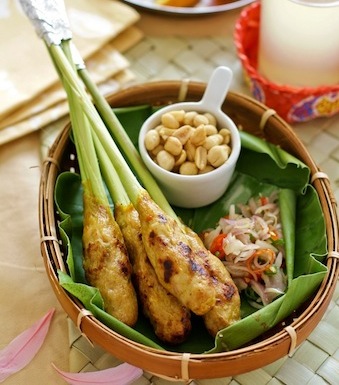The Balinese consider Western food flat and tasteless. Their own food tends to be peppery and served with such potent spices as mashed onions, garlic, fermented fish paste, and scalding red peppers. The most ramshackle roadside warung can bring forth an array of exquisite dishes with flavors , textures, and aromas that you never dreamed existed: tingling ginger sautes, sour but deep flavoured tamarind (celagi), rich and creamy peanut sauces, and the spice-laden chili condiment called sambal that will fire the palate. Bright orange-yellow turmeric (kunyit), a root of the ginger famiy that resembles a small carot, is frequently used in Balinese festival dishes to produce yellow-colored rice. Spices are ground into a paste in back of the family compound, using a black stone mortar (batu basa) and cone-shaped pestle (cantok). Surprisingly, one seldom comes across the spices – utmeg, pepper, mace, and cloves – that gave the “Spice Island” their name and spurred Columbus to accidentally discover America.
Coconut (nyuh), an essential ingredient in Balinese cooking, add richness to many native recipes, especially curries and sauces. At least 12 varieties of coconut, either green or yellow, are found on Bali. Able to produce fruit for 50 years, when coconut is old and dried out it turns gray. Coconut milk is made by shredding the meat of the old coconut, kneading, sieving, then blending it with water. As it cooks, the coconut milk thickens; with the addition of flour or corn starch it becomes a thick, white, rich cream (santen). Balinese-style sate is kneaded into coconut cream. The sweet, creamy contents of the young coconut (kuwud) also makes a refreshing drink. Any man of boy can shape a spout and spoon out of coconut husk so that you may drink right from the nut and scrape out the gooey meat.
Chilies (tabia), the elongated pods of the Capsicum pepper family, turn from green to red when ripe. Usually the largest sizes are used principally to decorate offerings, but the smallest (tabia kerinyi) are highly flammable! Chili bushes grow easily indide the family kampung, and chilies are plucked as needed. Chilies are de rigueur in any kind of sambal, and thin slices of chili go into the spicy-hot, salty, and popular Balinese soybean sauce called kecap which has nothing to do with tomato-based catsup as we know it. In restaurants there are almost always two kinds of kecap, sweet (kecap manis) and salty (kecap asin). There are many kinds of hot chili sauces (sambal) and spiced chii pastes. Almost every dish has its own kind of sambal, and every Balinese family makes its own a bit differently.
But don't get the idea that all Balinese food is hot. Many dishes are quite palatable to the westerner. When in doubt as to whether the dish is spicy hot or not, ask Pedas atau tidak? (“Hot or not?”). If the dish si too hot, don't try to douse the fire with a glass of cold water, cold beer, or a carbonated drink, which only exacerbates the problem. Instead, eat some boiled rice, cucumber, a banana, or some bread – al of which effectively absorb th potent chili oil. to make a dish less fiery hot, squeeze a little leon with some salt over it. Or drink hot tea or warm water which will sting at first, then bring relief.
Stay with us at Bali Ametis Luxury Villas, ee will ensure you will have unforgettable memories during you stay at Bali Ametis Luxury Villas. Copyright 2011, Ametis Villa – Bali Luxury Villas | Private Villa | Honeymoon Villa









